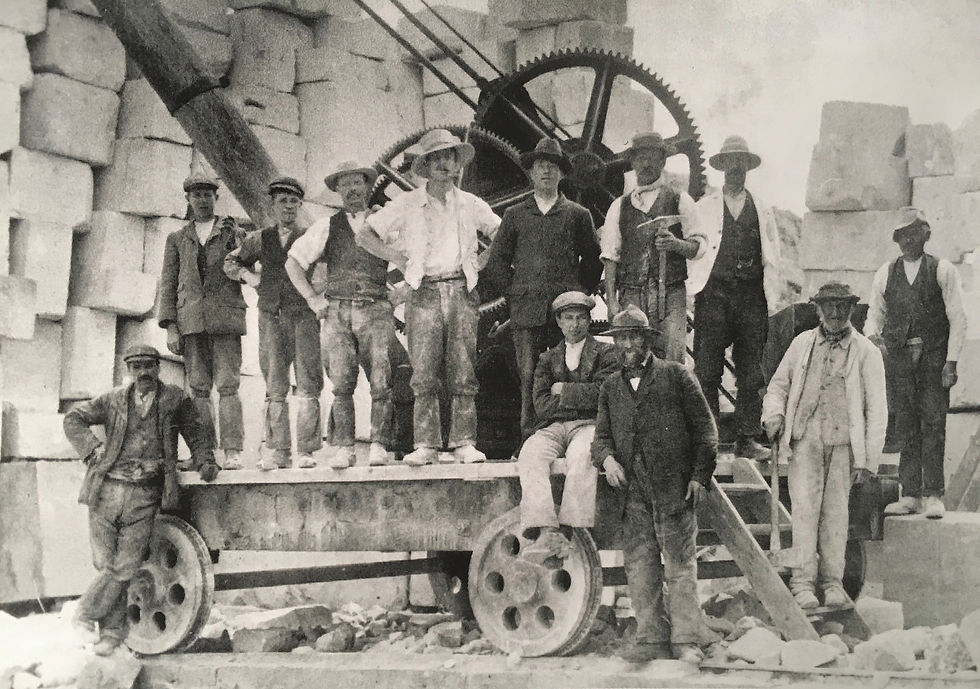
John Vaughan
1786-1869
Stonemason and builder
Author:
Michael Davis
Images:
Bath Stone Quarries
by Derek Hawkins,
Pub. Folly Books
Mostly Movies
John Vaughan was a Devonian and a Master Builder. He travelled to Bath in the early 1800s in order to participate in a building boom, which was being created in particular by the Pulteney family on the Bathwick Estate on the east side of the river. He was to stay for the rest of his life.
The Pulteneys had been in full flow on this project during the 20 year period after 1770 when they built their bridge to link with the City. The famous Pulteney Bridge was designed by John Adam. The area adjacent to it, including Great Pulteney Street and the first leg of Sydney Place, had been developed with large houses to let for the season to visiting royalty and nobility with plenty of servants. Not many of them are in single-occupancy today.
Following the Great Bath Banking Crash of 1793, and the onset of the Napoleonic Wars, development stopped for 20 years. When it got going again, it was on a very different plan. By the time John Vaughan arrived, around 1810, Bath had changed. The royalty and nobility had moved on to other venues, Brighton for example. But Bath was increasingly popular, and more vulgar. The development of the main part of the Estate, up the hill, was of more ‘modest’ houses for the burgeoning middle classes and built as permanent residences. These are now the typically grand houses of the modern world.
Initially John Vaughan worked in the stone quarries in and around Combe Down and was soon involved in the building of Hampton Row (1816-19), aged 29-32. The houses were not large but they were elegant. The Architect was John Pinch the Elder, leading Architect to the Pulteney family. The Builder was James Goodridge, father of his subsequent collaborator H E Goodridge, who became another famous architect. Vaughan made an impression here and these contacts were the springboard for his career. He had been living in Walcot but he then moved into No 8 Hampton Row as the first occupant, from 1819 to 1828. (photo?). The aspect from Hampton Row was much better then than it is now; in 1839 the route of the Kennet and Avon Canal, with a new high embankment, was altered to accommodate the route of the new Great Western Railway running next to Hampton Row.
Vaughan’s builder’s yard, employing 49 men, was at Sydney Wharf on the K&A Canal where it passes under Bathwick Hill (now the home of narrowboats). Here he built, in 1828 (aged 41), Raby Villa into which he moved himself and where he lived for 37 years. (photo) Raby is a family name related to the Dukes of Cleveland. The builders of Raby Castle had no formal title but from 1295 they were summoned to Parliament as Barons of Raby.
Around the time he moved to Raby Villa, his wife, Ellen Charmbury of Bathhampton, became ill. They had married In June 1814 when they were both 27, at Lyncombe and Widcombe Church. Their only child Maria was born a month later, in July. They had 15 years together until Ellen died at the age of 42 and was buried at Bathampton’s St Nicholas churchyard, an ancient church founded in 1261.
A year later in January 1830 John married his second wife Elizabeth, the daughter of the Brewer at Sydney Wharf, William Robinson. She was 26, eighteen years his junior. One of the witnesses at the wedding was his daughter Maria, then aged 16. They continued living in Raby Villa and were married for 37 years, but John and Elizabeth had no children.
In 1832 he built No.1 Sydney Buildings, then known as Raby House. Sydney Buildings were not built as a symmetrical row but piecemeal over the years. Numbers 2 to 6 had been built together in 1812 but the plot which was to be Number 1 had remained vacant for 20 years. John Vaughan bought the plot at auction from the Rev J M Rogers for £520; he bought it together with Edward King, Gentleman. It would seem an example of private financing between individuals which was the norm at the time. He was already living at Raby Villa, not far away on the other side of the Canal, so No 1 was a Build-to-Let. It is very well built.
The “Greek Revival” design of the front of the house, in the opinions of both Nicholas Pevsner and Michael Forsyth, is probably by the now-famous Henry (H E) Goodridge. The house is quite different in design from the rest of the street.
There was a long-standing working relationship between the two men, builder and architect. In 1827 Vaughan built the toll houses on Cleveland Bridge designed by Goodridge, who has his name on a plaque on the bridge. (photos?)
Goodridge was commissioned to design the famous Lansdown Tower, known as Beckford’s Tower. In the construction documentation is an invoice to John Vaughan, builder, so this would have been the climax of John Vaughan’s career. (photo)
John Vaughan and his daughter Maria (Lewis) both died in the same year,1869.
There are no known photographs of Vaughan or his family but in a book Images of the Kennet and Avon Canal there is one of his builder’s cart. He and Elizabeth are buried together in Smallcombe Cemetery and there is a brass plaque to them both in St Mary’s Church, Bathwick.
Bibliography:
Images of the Kennet and Avon Canal, Niall Allsop.
Known for...
Master builder of late Georgian and Victorian Bath. Worked on Beckford's Tower and Sydney Buildings.
Gallery











